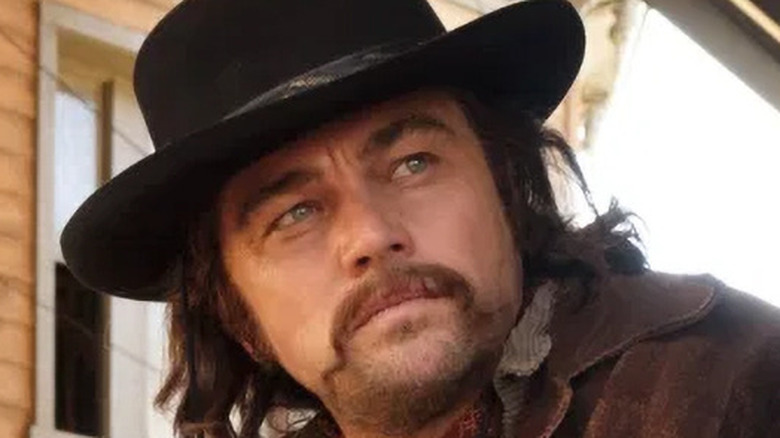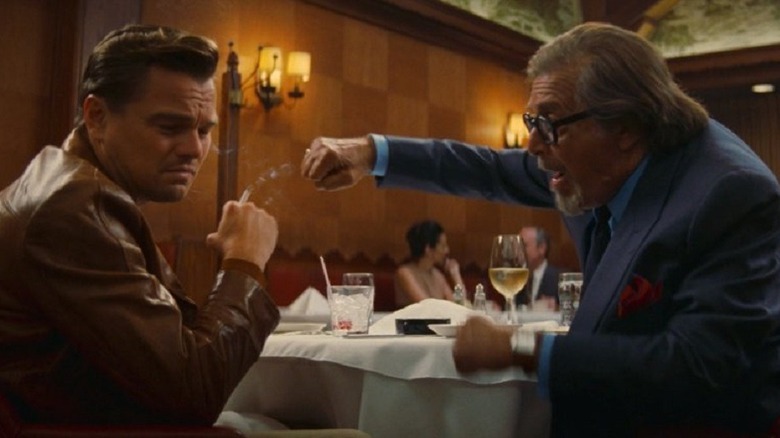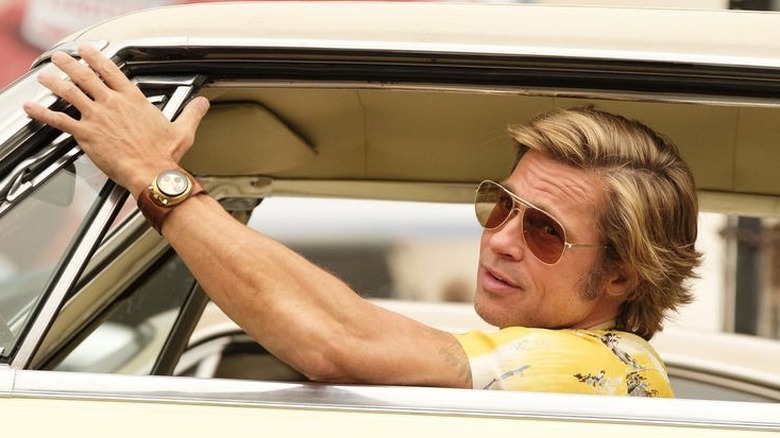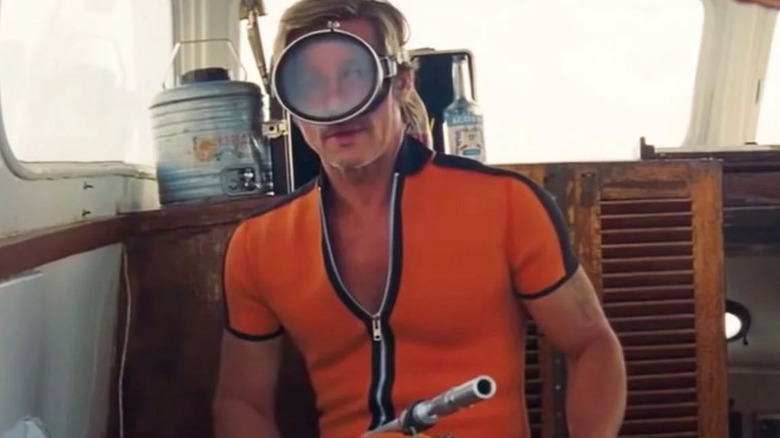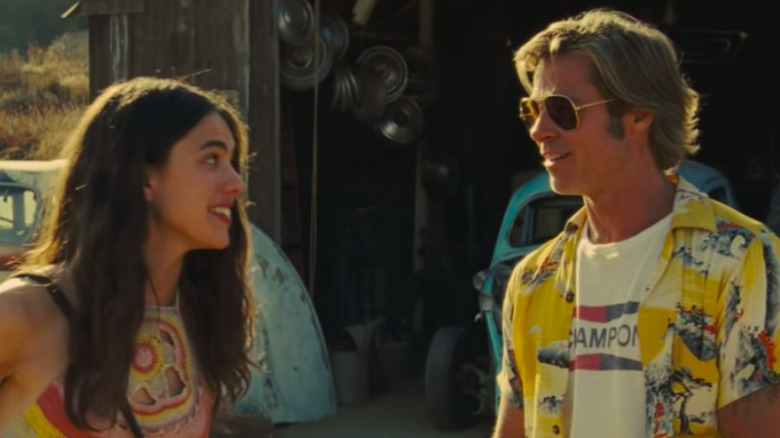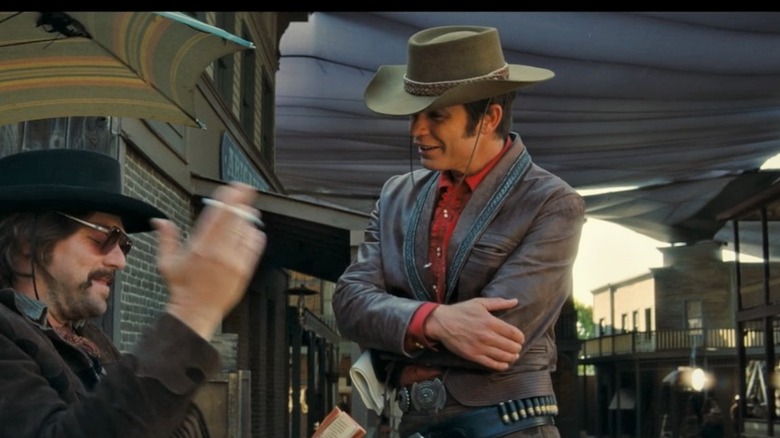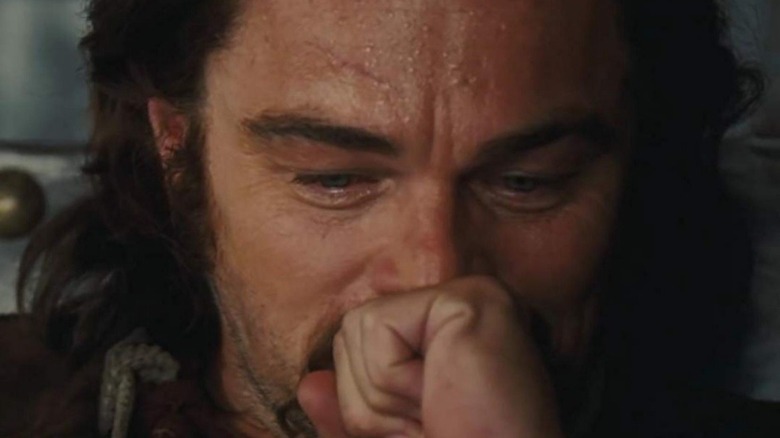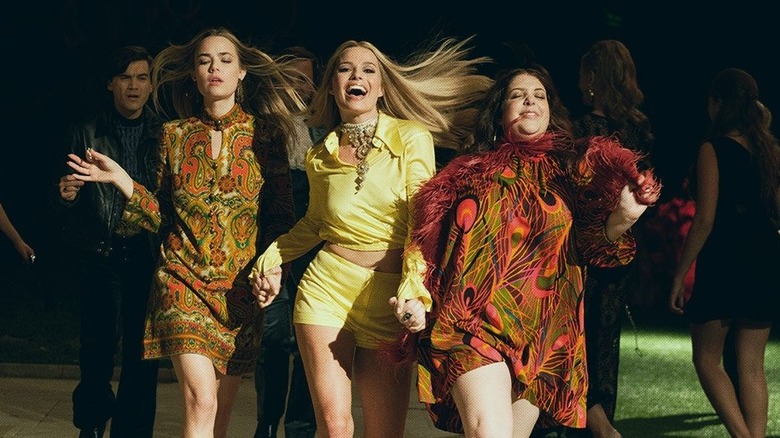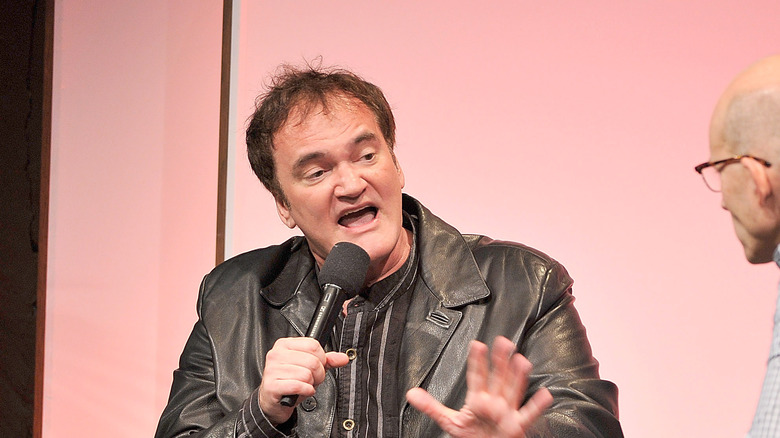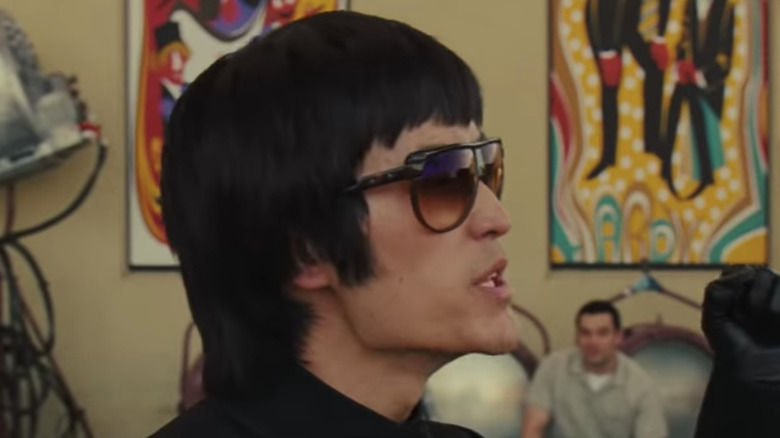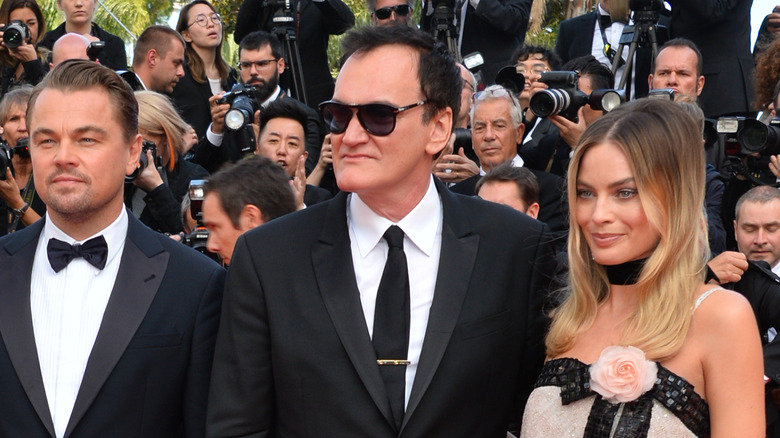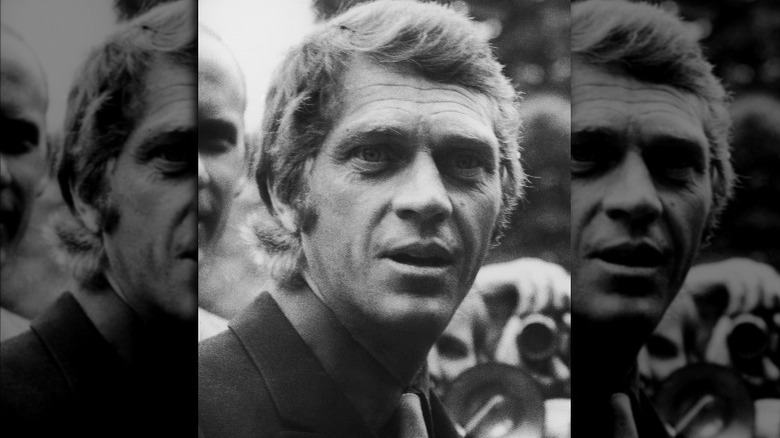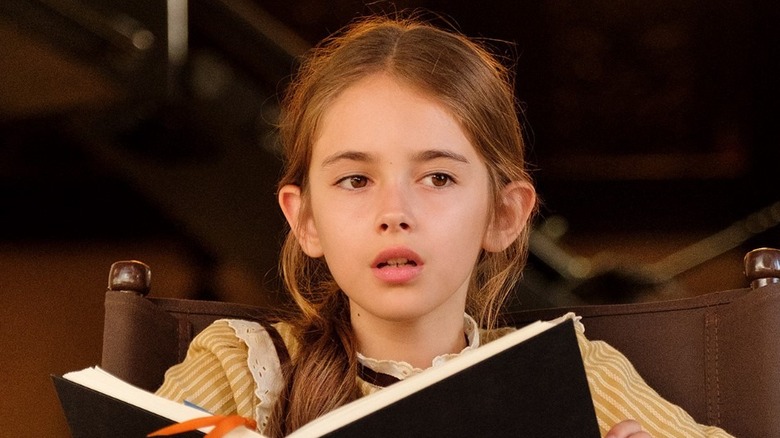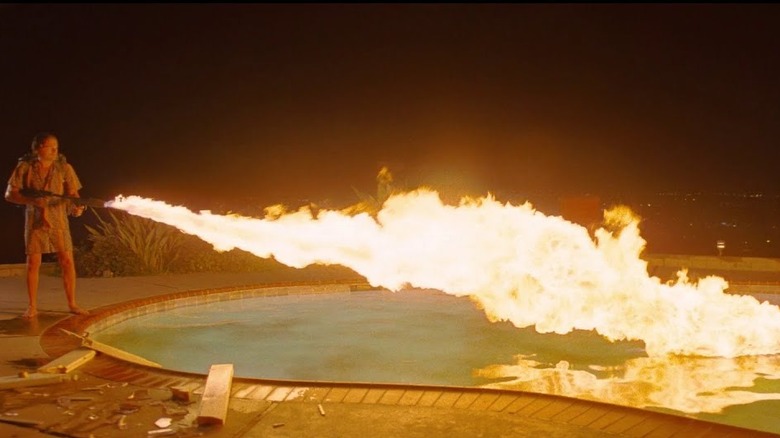How The Once Upon A Time In Hollywood Movie Differs From The Book
Hollywood is a magical place. But its bright lights are matched by dark undercurrents of violence, destitution, and broken dreams. Nobody knows this better than Quentin Tarantino, and none of his films put this truth more on display than "Once Upon a Time in Hollywood." This 2019 film is the auteur's most passionate love letter to the movie business and Los Angeles as a whole. While it's chock-full of hat-tipping to the giants of Hollywood past, the novel is even more stuffed with Tarantino's encyclopedic film knowledge.
"Once Upon a Time in Hollywood," Tarantino's 2021 novelization of the hit film, wears its attitude on its cover: "Hollywood 1969 ... You shoulda been there!" reads the tagline above the title of the novel. Indeed, this book is filled with actors, directors, films, and TV episodes probably only Tarantino and certain members of the American Film Institute recognize in full. It also changes quite a few things from the movie. Character arcs are expanded, events take place at different times, and secrets are revealed that the 2019 film never touches on. These are the key differences between the "Once Upon a Time in Hollywood" movie and the novelization, from Trudi Frazer's future to Rick's conversation with Steve McQueen.
The opening meeting happens in a different place
The film opens with a "Bounty Law" interview that introduces Rick Dalton (Leonardo DiCaprio) and Cliff Booth (Brad Pitt). The first real scene follows, in which Rick meets with Marvin Schwarz at standby Hollywood eatery Musso and Frank. In the book, this scene happens at Schwarz's agency office.
Why was this scene changed? The reason is twofold. First, the old Hollywood charm of Musso and Frank would be lost on the page. Second, a Hollywood power lunch isn't really the place to get into the nitty-gritty of how the business works — and that's exactly what goes down in the book's rendition of this scene. This is where Tarantino establishes the tone of the book, especially how peppered it is with name-dropping and film lore.
Rick notes that "The 14 Fists of McCluskey," a fictional movie and Rick's top credit, was directed by his mentor, Paul Wendkos. "They want Marlon Brando; they get Burt Reynolds," Schwarz explains. "They want Warren Beatty; they get George Hamilton ... But the reason they want you is they want Steve McQueen. ... And when they finally realize they're not going to get McQueen, they're gonna want a McQueen they can get. And that's you."
Rick starts crying, which no doubt Schwarz was expecting, and would have been all the more awkward at Musso and Frank.
Cliff feels like the lead
"Once Upon a Time in Hollywood" follows Rick on his quest to rebuild his career. But the film's climax is the battle against the Manson family, and Cliff is the hero of that encounter. It could be argued, then, that Cliff is the lead. In the book, Cliff's presence is even more pronounced.
Notably, Cliff's backstory is dramatically expanded in the novel. While he's the stunt double and Rick's the "artist," Cliff is revealed in the book as a cinephile who prefers foreign films. He even takes Schwarz's assistant to see the infamous Swedish film "I Am Curious (Yellow)." Cliff dislikes the pretty-boy American actors of the '60s, his favorite performer being Toshiro Mifune. He also has strong opinions about Italian films, which adds depth to the moment in the movie when he tells Rick that "going to Rome to star in movies does not sound like [a] fate worse than death."
Because the book doesn't dwell as much on the final scene, an argument could be made that Cliff is less of a lead in the book than he is in the film. But the enormous amount of page time he gets, including a memorable night in which he talks to Aldo Ray during a shoot in Spain, makes up for this diminishment.
Cliff's chilling history
The "Once Upon a Time in Hollywood" novel loosely follows the arc of the movie, with some scenes recreated line-for-line. Where the book shines as its own creation, however, is in its explorations of characters' histories. Cliff gets the most focus of anyone.
We learn that Cliff had quite the career in World War II: "Except for the fellas that dropped the bomb on Hiroshima, no other American soldier had more confirmed kills of Japanese enemy soldiers than Sergeant Clifford Booth." Cliff also escaped a Japanese POW camp, inspiring the movie "Battle of the Coral Sea," in which Rick appears.
In another chapter, Cliff is accosted by mobsters. He says, "For the day I got [one of his Medals of Honor] I killed at least seven [Italians]. Maybe as many as nine." He proceeds to shoot them. This is noted as the first time Cliff gets away with murder. The second time is with his wife, a fact only hinted at in the movie. The book describes how he shoots her with a shark gun, then holds her as she clings to life. They recount their love until the Coast Guard pulls the boat in, and she finally dies. Cliff tells the police the gun misfired, and without any other proof, they have to go on his word. But yes, Cliff did kill his wife.
How the gang gets together
Without a runtime to stick to, the novel is able to detail how many of the characters first meet. Cliff and Rick meet when Cliff is brought in to stunt double for him on "Bounty Law." Originally, Rick doesn't like him, because Cliff is too handsome. But when Rick catches on fire during a stunt, Cliff helps put him out. Plus, Rick can't help but be impressed by Cliff's war history.
Cliff meets Brandy, his dog, in a very different way. She's brought to him by a stuntman friend who owes Cliff money. Together, they put her in dog fights. One day, however, an injured Brandy ends up facing a difficult fight. Cliff's friend insists on fighting her regardless, so Cliff kills his friend and keeps Brandy.
Charles Manson meets Pussycat through her father. Debra Jo Hillhouse's dad picks up Manson, who is hitchhiking, and takes him home for dinner. Manson meets the man's 14-year-old daughter, has sex with her, and promptly drives off with her in her dad's car. Manson convinces her to get married so she can be emancipated and come join Manson's family, and names her Pussycat for her "unaffected little kitten quality." Manson is so charismatic, Debra Jo's father even tries to join his twisted family.
Real-life backstories galore
In the novel, real-life record producer Terry Melcher and Brian Wilson of the Beach Boys are both infatuated with Pussycat. This infatuation leads to them letting Charles Manson hang around. It also leads to Terry Melcher entertaining Manson's dreams of becoming a professional musician, though he ends up no-showing a special demo Manson sets up at Spahn Ranch. This is why Manson goes to the house Melcher used to rent, newly inhabited by Roman Polanski and Sharon Tate.
That isn't the book's only dive into the histories of its real-world characters. One chapter follows Sharon Tate as a younger woman, hitchhiking across Texas until an old cowboy picks her up. Other real-life stories include an exploration of the TV show "Lancer" — specifically, its pilot, in which Rick appears as the villain. James Stacy makes an appearance (played by Timothy Olyphant in the film): He plays Johnny Madrid on the show, who's actually Johnny Lancer, one of two brothers set to inherit their father's empire. Said empire is jeopardized by Johnny's friend, Caleb DeCoteau (played by Rick). In the book, we get to finish the episode and see Johnny Madrid Lancer kill his old friend.
Rick is struggling – like most of Hollywood
Rick obviously has a drinking problem. But in the book, we see how deep his struggles go. The night before Rick stars in his pilot, he doesn't just get drunk — he gets blackout drunk. "Most actors and actresses in the sixties had a couple of cocktails ... to wind down with once they got home," the book notes. "But Rick turned a couple whiskey sours at the end of the day into eight whiskey sours." Rick is far from alone in this, however. One scene featuring real-world actor Aldo Ray details his drinking problem, which is so dire, everybody in his movies is contractually barred from providing him with booze.
The book also explores Rick's emotional turmoil. "Since high school," we learn, "Rick had experienced violent mood swings. His blues were bluer than most, and his highs could border on manic." Rick shares this with real-world actor Pete Duel, who Rick meets on a film in Mexico. The two of them share a rip-roaring time, "but they shared something else, something neither knew intellectually but both sensed internally. Both Dalton and Duel were undiagnosed bipolar. And drinking alcohol was their only form of self-medication."
Many big set pieces are glanced over
The Playboy Mansion in 1969 was the party place. The scene in the movie in which Roman Polanski and Sharon Tate attend a party there is a visual dream. However, much of that scene's charm is due to the sight of 1969 glitterati dancing around the pool and grotto — something difficult to recreate on the page. That's likely why Tarantino did not include it in the novel. In the movie, this scene also provides an opportunity for Steve McQueen to deliver some exposition on the Sebring-Tate-Polanski relationship. In the book, this is only referred to as the reason Polanski has a hangover.
The Playboy Mansion scene isn't the only lavish set piece missing from the book. All of Rick's acting scenes are cut, and of course, the epic finale in which Cliff fights off the Manson family murderers is dramatically cut down. It gets mentioned on page 110, in a phone call between Rick and his mentor, Paul Wendkos. The fight is mostly boiled down to a single line: "Rick and Cliff made short order of the housebreakers, killing all three in a brutal fight." Perhaps Tarantino, knowing the limitations of action in a novel, decided there was no way his prose could do it justice.
Tarantino really geeks out in the book
Quentin Tarantino is renowned for possessing a vast trove of knowledge about basically everything having to do with moving pictures. While you might have heard him discuss his passion in interviews or on podcasts, the "Once Upon a Time In Hollywood" novel is where Tarantino truly lets his geek flag fly.
The first chapter digs deep into Rick's filmography, something Tarantino discussed researching on an episode of the Pure Cinema Podcast. Tarantino went through series and films from the 1960s and 1950s to find ones Rick Dalton could've played a role in. This, of course, led to deep consideration of the actors, directors, and other talents Rick might have worked with. If you're a cinephile, you'll want to read this book with a notepad to jot down films, actors, and directors to check out. The names come fast and furious, as when Rick explains his first lead role in "a hot rod picture for Republic called 'Drag Race, No Stop.' Bill Whitney directed it. It had a good cast, Gene Evans, John Ashley, Dick Bakalyan. I beat out Bob Conrad for the lead."
Bruce Lee comes off worse in the book
Bruce Lee (Mike Moh) is portrayed in the film as a cocky blowhard. This depiction received blowback, especially from Lee's daughter, Shannon Lee (via Deadline). As it turns out, however, the book's take on Bruce Lee is even more conceited. Moreover, it adds in Cliff letting Lee get the first blow in during their fight, to set up the second.
The book also gets into claims that Bruce Lee disrespected stuntmen, often "tagging" them, or actually hitting them. This leads to the idea of "the ringer." When an actor has been tagging stuntmen, Cliff, a ringer, is brought in by the stunt coordinator for a day. He hits back against the actor, humbling him for the rest of the production. Cliff is then "fired" from the job with a fat paycheck and thanks from the stuntmen and others. Cliff is portrayed, then, as noble for taking down Lee. This has been met with renewed criticism (via Firstpost).
Quentin Tarantino appears in the book
Quentin Tarantino has appeared in front of the camera many times. He plays a major role in "Reservoir Dogs" and "Pulp Fiction," stars in Robert Rodriguez's "From Dusk Till Dawn" and "Planet Terror," and narrates "The Hateful Eight." While he doesn't appear in the cinematic version of "Once Upon a Time in Hollywood," he does pop up in the book.
Tarantino is mentioned as the director of a 1999 remake of John Sayles' script for "The Lady in Red." He also appears, if obliquely, in another scene, in which Rick, Cliff, Jim, and other Hollywood types drink at a bar called The Drinker's Hall of Fame. While there, Rick and Cliff are introduced to piano player Curt Zastoupil, Quentin Tarantino's real-life stepfather. The actor Warren Vanders shows up, and the book mentions that Vanders "gave Curt's son his first dog, named Baron." Zastoupil asks Rick to sign a photo for his son, Quint (short for Quentin), since the boy's a fan. Rick signs a napkin to "Private Quentin," telling him that "Maj McCluskey and Sgt Lewis salute you." He adds a drawing of Sgt. Lewis (Rick's character) wearing a t-shirt that says "Quentin Is Cool." Now that's something that might lead a 6-year-old boy into a lifelong love of film.
A lot more Steve McQueen
One real-life actor who gets much more exposure in the book is Steve McQueen. McQueen, played by Damian Lewis, appears in one scene in the movie, in which he explains the Polanski-Tate-Sebring relationship to Connie Stevens. There is also a reference to Rick almost getting the McQueen role in "The Great Escape." In the book, however, Rick gets asked to repeat this story over and over again, with each time making him feel worse.
Rick, who is referred to as a poor man's McQueen, comes face to face with him in the book. McQueen is on his way to a party at the Polanski residence when Rick comes out with his stein of whiskey sour. He sees McQueen, and they talk about the old days. Rick's thoughts dwell on how McQueen's the highest-paid actor in Hollywood, and he, in brutal comparison, is a has-been. But they also discuss a time when they played pool at Barney's. "Well it was a big deal," McQueen says. "Josh and Jake playing pool?" This refers to Rick's role as Jake Cahill and McQueen's as Josh Randall on the real-world series "Wanted Dead or Alive."
More Trudi Frazer
Brad Pitt and Leonardo DiCaprio may have been the leads, but Julia Butters steals the show. Her preternaturally precocious Trudi Frazer — who introduces herself as her character, Mirabella Lancer — is far more grown-up and professional than the hungover mess that is Rick Dalton. We're happy to report she gets a lot more time in the book.
In one scene, she and Rick discuss the craft of acting. She challenges Rick to a "what if" exercise: What if his character, Caleb DeCoteau, doesn't get the ransom he requests — would he actually kill the girl? She eventually posits that no, he would fall in love with her, but she would be the boss. Rick says this is weird, but her desire to seem grown-up and her passion for acting actually sparks great work from the both of them.
Trudi's most memorable appearance in the book actually began as a scene filmed for the movie. This scene was, in fact, Tarantino's favorite (via The Hollywood Reporter). Cutting it was difficult, but deemed necessary for the movie's purposes. The book, however, is its own creature, and the scene unfolds in full within it. Trudi and Rick rehearse lines over the phone. The young actress, so full of talent and hope, pulls the old veteran off the proverbial ledge in the process. This is the final scene in the book, and it packs an emotional punch.
The book looks forward to Rick and Trudi's careers
As the book details, "Trudi Frazer never did win an Oscar. But she was nominated three times." The third nomination was for her role in the previously mentioned remake of "The Lady in Red," directed by Quentin Tarantino. "Rick," the book notes, "rooted for her every time."
The book foretells Rick's future as well, which is filled with juicy film and TV roles, recurring appearances on Johnny Carson's "The Tonight Show," and general success and fame. Rick works again with director Paul Wendkos, and even plays a role similar to Steve McQueen's in one of the "Magnificent Seven" sequels. Where does Rick's newfound fame come from? From the night that he and Cliff fought off some hippies "out to perform a Satanic ritual," as the book describes the LAPD's theory.
"Pretty soon," the novel muses, "the whole ghastly night of violence became heavy with symbolic weight — turning Rick, the former TV cowboy, into a folkloric hero of Nixon's silent majority." Rick later tells Cliff, "All in all, those goddamn hippies did me a favor." And everybody lived happily ever after.
